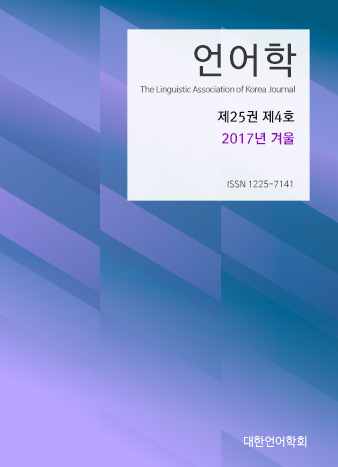대한언어학회 전자저널

25권 4호 (2017년 12월)
- 영어 보충어와 부가어의 통사⋅의미적 차이점에 대한 연구
-
이종근 & Jocelyn Wright
Pages : 143-166
Abstract
Lee, Jong Kun & Wright, Jocelyn. (2017). Syntactic and semantic differences between complements and adjuncts in English. The Linguistic Association of Korea Journal, 25(4). 143-166. The distinction between complements and adjuncts plays an important role in syntax and semantics. The purpose of this study is to investigate syntactic and semantic differences between the two in English. Previous studies make use of a group of syntactic tests including the do so test and iterability test and adopt a set of semantic criteria to distinguish complements from adjuncts. Most researchers (Dowty 2000, Aarts 2013, among others) assume that dependents of a predicate can be exhaustively divided into complements and adjuncts. Expanding Grimshaws (1990) idea, DeArmond & Hedberg (1998, 2009), however, argue that some dependents of predicates are neither complements nor adjuncts. They refer to these as secondary complements. DeArmond & Hedberg (1998, 2009) claim that prepositional phrases (PPs) denoting a location are adjuncts, and PPs denoting a goal or source are primary complements. This study, however, argues that some location-denoting PPs are neither pure complements nor pure adjuncts, but a mixed category (adjunct-complements) sharing the properties of both. Moreover, it shows that a set of syntactic tests and semantic criteria indicate that verbs such as live, stand, and reside require location-denoting PPs as adjunct-complements, and verbs such as appear, step, march, and land take goal-denoting or source-denoting PPs as adjunct-complements.
Keywords
# 보충어(complements) # 부가어(adjuncts) # 장소(location) # PP # 통사적 테스트(syntactic tests) # 부가어성 보충어(adjunct-complements)
References
- Aarts, B. (2013). English syntax and argumentation (4th ed.). New York, NY: Palgrave Macmillan.
- Baker, C. L. (1978). Introduction to generative-transformational grammar. New York, NY: Prentice-Hall.
- Bresnan, J. (1982). The mental representation of grammatical relations. Cambridge, MA: MIT Press.
- Celce-Murcia, M., & Larsen-Freeman, D. (1999). The grammar book: An ESL/EFL teacher’s course (2nd ed.). Boston, MA: Heinle and Heinle.
- Collins Education. (2017). COBUILD English grammar (4th ed.). Glasgow: HarperCollins.
- Chomsky, N. (1970). Remarks on nominalization. In R. A. Jacobs & P. S. Rosenbaum (Eds.), Readings in English transformational grammar (pp. 184-221). Waltham: Ginn.
- Chomsky, N. (1994). Bare phrase structure. MIT Occasional Papers in Linguistics #5.
- Cowan, R. (2008). The teacher's grammar of English: A coursebook and reference guide. New York, NY: Cambridge University Press.
- DeArmond, R. C., & Hedberg, N. (1998). On complements and adjuncts. In Proceedings of the 1998 Annual Conference of the Canadian Linguistics Association, University of Ottawa: Cahiers Linguistiques d’Ottawa.
- DeArmond, R. C., & Hedberg, N. (2009). On complements and adjuncts. Snippets, 19, 11-12.
- Dowty, D. (2000). The dual analysis of adjuncts/complements in Categorial Grammar. Zas Papers in Linguistics, 17, 1-26.
- Grimshaw, J. (1990). Argument structure. Cambridge, MA: MIT Press.
- Hole, D. (2015). Arguments and adjuncts. In T. Kiss & A. Alexiadou (Eds.), Syntax - theory and analysis: An international handbook. Berlin: Mouton de Gruyter.
- Huang, C.-T. J. (1982). Logical relations in Chinese and the theory of grammar. Unpublished doctoral dissertation, MIT, Cambridge, MA.
- Jackendoff, R. (1977). X′Syntax: A study of phrase structure. Linguistic Inquiry Monographs 2. Cambridge, MA: MIT Press.
- Lakoff, G., & Ross, J. R. (1966). Criterion for verb phrase constituency. Technical Report NSF-17, Aiken Computation Laboratory, Harvard University.
- Pollard, C., & Sag, I. (1987). Information-based syntax and semantics Vol. 1: Fundamentals. Center for the Study of Language and Information, Stanford University.
- Scrivener, J. (2010). Teaching English grammar: What to teach and how to teach it. London: MacMillan. Yule, G. (1998). Explaining English grammar. Oxford: Oxford University Press.